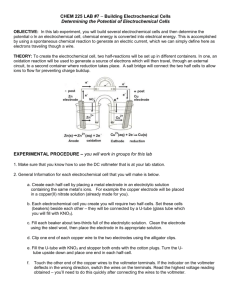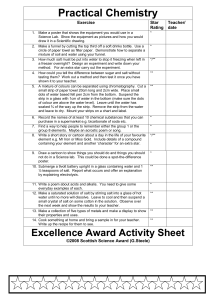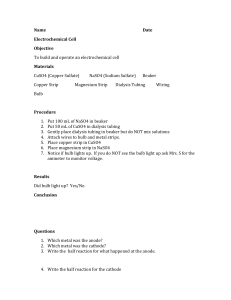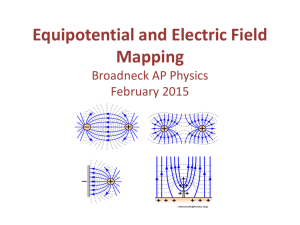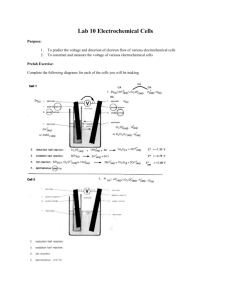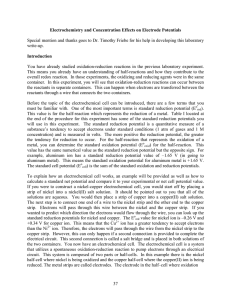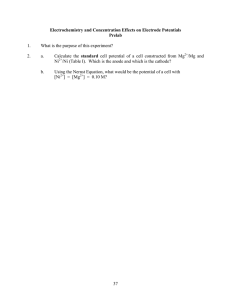T09D05 – Electrochemical Cell Lab Measuring the Potential
advertisement
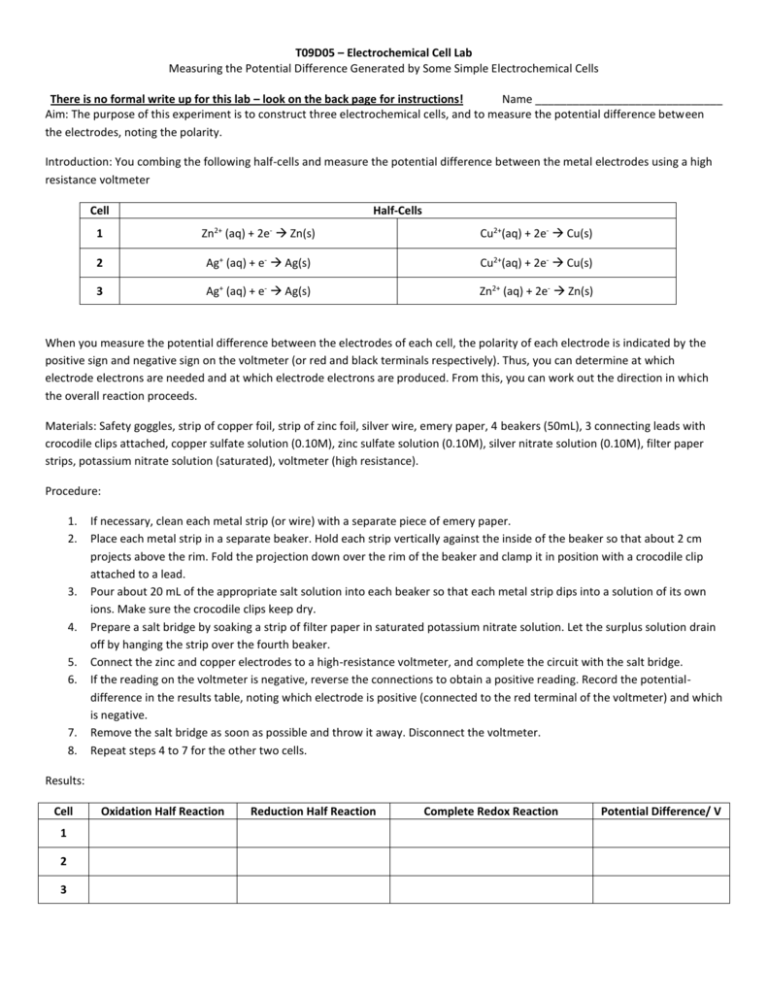
T09D05 – Electrochemical Cell Lab Measuring the Potential Difference Generated by Some Simple Electrochemical Cells There is no formal write up for this lab – look on the back page for instructions! Name ______________________________ Aim: The purpose of this experiment is to construct three electrochemical cells, and to measure the potential difference between the electrodes, noting the polarity. Introduction: You combing the following half-cells and measure the potential difference between the metal electrodes using a high resistance voltmeter Cell Half-Cells 1 Zn2+ (aq) + 2e- Zn(s) Cu2+(aq) + 2e- Cu(s) 2 Ag+ (aq) + e- Ag(s) Cu2+(aq) + 2e- Cu(s) 3 Ag+ (aq) + e- Ag(s) Zn2+ (aq) + 2e- Zn(s) When you measure the potential difference between the electrodes of each cell, the polarity of each electrode is indicated by the positive sign and negative sign on the voltmeter (or red and black terminals respectively). Thus, you can determine at which electrode electrons are needed and at which electrode electrons are produced. From this, you can work out the direction in which the overall reaction proceeds. Materials: Safety goggles, strip of copper foil, strip of zinc foil, silver wire, emery paper, 4 beakers (50mL), 3 connecting leads with crocodile clips attached, copper sulfate solution (0.10M), zinc sulfate solution (0.10M), silver nitrate solution (0.10M), filter paper strips, potassium nitrate solution (saturated), voltmeter (high resistance). Procedure: 1. 2. 3. 4. 5. 6. 7. 8. If necessary, clean each metal strip (or wire) with a separate piece of emery paper. Place each metal strip in a separate beaker. Hold each strip vertically against the inside of the beaker so that about 2 cm projects above the rim. Fold the projection down over the rim of the beaker and clamp it in position with a crocodile clip attached to a lead. Pour about 20 mL of the appropriate salt solution into each beaker so that each metal strip dips into a solution of its own ions. Make sure the crocodile clips keep dry. Prepare a salt bridge by soaking a strip of filter paper in saturated potassium nitrate solution. Let the surplus solution drain off by hanging the strip over the fourth beaker. Connect the zinc and copper electrodes to a high-resistance voltmeter, and complete the circuit with the salt bridge. If the reading on the voltmeter is negative, reverse the connections to obtain a positive reading. Record the potentialdifference in the results table, noting which electrode is positive (connected to the red terminal of the voltmeter) and which is negative. Remove the salt bridge as soon as possible and throw it away. Disconnect the voltmeter. Repeat steps 4 to 7 for the other two cells. Results: Cell 1 2 3 Oxidation Half Reaction Reduction Half Reaction Complete Redox Reaction Potential Difference/ V Questions: 1. Provide the shorthand notation for each of the cells provided. Cell 1 Shorthand Electrochemical Cell Notation Cell 2 Cell 3 2. What is the function of the salt bridge in the cells? 3. Pick one cell and draw, diagram or take a picture and label each part of the three cells: cathode, anode, salt bridge, oxidized compound, reduced compound, oxidizing agent, reducing agent, potential difference, solutions, etc. Extension: Design Lab SL – You are to set up an Electrochemical Experiment in which you will develop a procedure to test the validity of various potential difference calculations. HL – You are to set up an Electrolysis Experiment to test a specific variable (concentration, distance, solution, etc) and its impact on the potential difference. Please check with me ahead of time to be sure that we have equipment necessary. Each lab (SL and HL) will be graded on all three parts of the laboratory experiment (D, DCP, CE) and will be due Friday, October 16th! If you leave early for break, be sure to turn in ahead of time!!! The lab will be planned and should have a completed background, variables, materials, procedure, and data table set up for Monday. On Monday you will complete the lab (modifications to the procedure can be made at this time). If you have any questions please see me.
